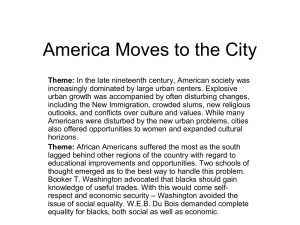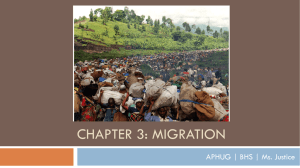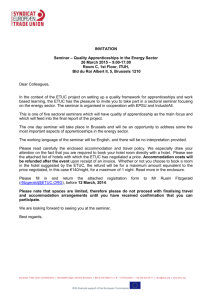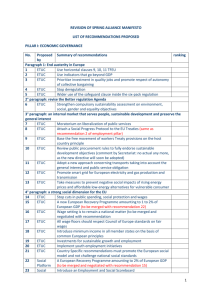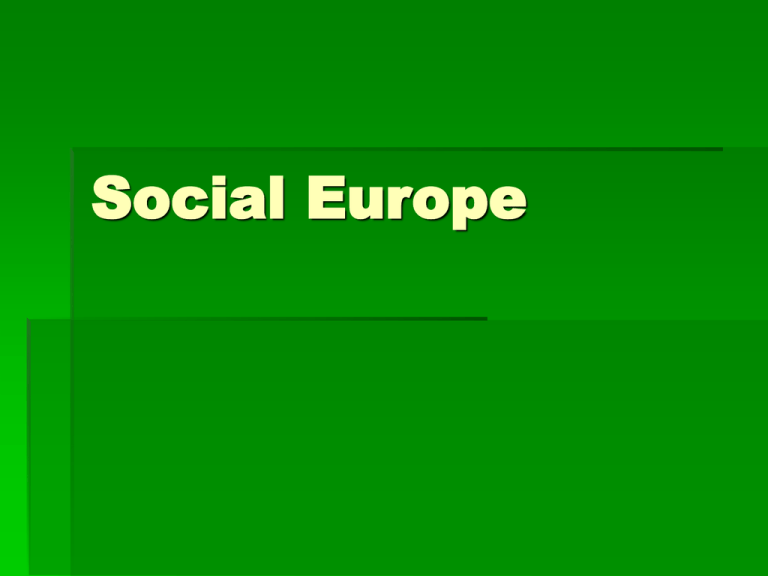
Social Europe
Topics
Social Policy in the EC/EU
European Labor
Environment
Free Movement of Persons and
Immigration
Social Policy in EC/EU
What is “Social Policy” about?
History
Women
Institutional articulation of Social Policy
DGs
Social Policy – What? (1)
The worker/employee dimension of integration
Employment and wages
Protections and rights at work
Participation in decision-making
Vocational training
The welfare dimension
Social security (in the European sense) and other
“citizen” benefits: social insurance and redistributive
policy
Social Policy – What? (2)
The free movement dimension
Transportable qualifications, certifications, and
benefits (eg pensions)
Collective presence and involvement on the
EC/EU level
“Social dialogue”
Industrial democracy and collective bargaining
European Social Fund
Corrective action to internal market effects
Social Policy – History (1)
Treaty of Rome
“Neoliberal” bias
The “social” as re-enforcement of market liberalization and
competition (to avoid “social dumping”)
Strong “ambiguity” in the language of Article 117
Social improvement will result from common market
Social improvement will result from “law, regulation or
administrative action”
Lack of clarity about responsible institutions –
Commission or Council?
Social Policy – History (2)
Social Policy emerges: 1969/72 – 1980
Social Action Program (adopted 1974)
40 initiatives in 3 priority areas: employment, living and
working conditions, participation
Employment directives
Worker participation
European Company Statute (proposed)
Fifth directive on structure of public limited companies
(proposed)
Equal treatment for women and men
Health and safety regulation
Social Policy – History (3)
Contrasting trends of the 1980s
De-regulatory climate questions the
approach of “partial alignment”
Flexible and minimally regulated labor markets
as the priority
Labor costs as paramount concern in the face of
competition (both internal and global)
Emerging consensus about “subsidiarity”
Val Duchesse and Social dialogue (1985)
Social Policy – History (4)
The 1980s (cont’d)
SEA and the Social Charter (1989)
Social Action Program (47 initiatives by the
Commission) to accompany Social Charter
The Treaty of Maastricht
The “Social Protocol” (Protocol on Social
Policy) to which an “Agreement” is annexed
Eleven of the twelve Member States (UK 1997)
A complex legal precedent
Social Policy – History (5)
The Treaty of Maastricht (cont’d)
The Economic and Social Committee
Strengthened role
Strong presence of organized labor (one of the
“social partners”)
Broad implications of EU citizenship
Relation between strong citizenship and high
common social standards (social solidarity)
Social Policy – Women (1)
The issues
Equal pay: embodied in Treaty of Rome
Equal treatment: not in Treaty of Rome but pursued
as an extension of equal pay
Others: pregnancy and maternity, sexual
harassment, “atypical workers,” childcare
The proactive 1970s: three directives
Equal Pay Directive (1975)
Applies “equal pay” principle of Treaty of Rome as same
work or work of equal value
Social Policy – Women (2)
The proactive 1970s (cont’d)
Equal Treatment Directive (1976)
No discrimination on grounds of sex in access to
employment, promotion, vocational training or
working conditions
Social Security Directive (1978)
No discrimination in certain aspects of state
social security
Creation of Equal Opportunities Unit in DG5
Social Policy – Women (3)
Implementation and Study
Actions Programs: 1982-85, 1986-90, 199195
See Bulletin: Supplement 3/86 for “vision thing”
Liberal (“far-reaching”) rulings of European
Court of Justice
Sexual harassment legislation adopted in
2002, applicable in 2005
Social Policy – Institutions
(1)
The “Big Picture”
Social policy as a crucial “turf” of European nationstate sovereignty, especially in postwar era:
differences are the norm
Social policy approach as ideological divide
between more “socialist” interventionist approach
and more “neoliberal” flexible and voluntarist
approach
The central role of the Commission
Early efforts of Commission to be more proactive
thwarted by Member States (1960’s)
Social Policy – Institutions
(2)
The Commission (cont’d)
Social policy revival in 1970’s requires
Council + Commission initiative
Jacques Delors’ strong personal
commitment to “the social” (social space) in
his implementation of Single Market initiative
of late 1980’s
Bias of the Commission towards
interventionist approach to social policy
Social Policy – Institutions
(3)
The Commission (cont’d)
Yet tempered by new accent on flexibility,
subsidiarity, and the overall preference of
the EC for deregulation and international
competitiveness
Subsidiarity and “mutual recognition” replace
“partial alignment” (a form of harmonization) as
guiding principle of social policy initiatives
Social Policy – Institutions
(4)
Decision-making
SEA introduces QMV for social policy
initiatives required to implement internal
market
Strong for health and safety regulation
Social Protocol to Maastricht Treaty extends
QMV to certain other areas for 11 signers
Working conditions, information and consultation
of workers, equality between men and women,
and integration of unemployed into labor market
Social Policy – Institutions
(5)
Decision-making (cont’d)
Unanimity still required for worker
participation, social security, protection of
third-country nationals
European Social Fund
The main policy instrument for social policy
Shift in emphasis from dealing with specific
effects of internal market adjustment to the
general problem of unemployment
Social Policy – Institutions
(6)
European Social Fund (cont’d)
Assimilation since 1988 into Structural
Funds has generated:
Substantial increase in amount of funds available
Shift to aiding less developed countries and
regions
In sum, part and parcel of “cohesion policy”
Specific funding to vocational training
Social Policy - Websites
DGs
Click on the following DGs:
Employment and Social Affairs
Link “Employment and Social Affairs”
Search engine for labor: ETUC, European
Framework Agreement
Environment
Justice and Home Affairs
Link “Free movement”
European Labor (1)
Organized labor and European integration:
Complexities and issues
Early enthusiasm for integration (eg, for ECSC) gives way to
concern with neoliberal and economic emphasis of EEC
(Treaty of Rome)
Organized labor’s own fragmentations complicates its early
attitudes and roles
Very different national traditions and bargaining frameworks
Broad ideological divisions: Socialist (majority, broad consensus),
Communist, and Christian unions
Pre-existing international (not only European) organization
roughly defined by these ideological tendencies: ICFTU is the big
one
The founding of the ETUC in 1972
European Labor (2)
The ETUC
A confederation of national trade union confederations
European-wide (not only EC or EU) but with a focus on EC/EU
matters
Secretariat in Brussels
Specialized roles of internal units
15 Industry Committees (sectoral specialty)
10 Interregional Trade Union Councils (cross-border, or regional,
specialty)
Close liaison with the EU
Partial funding from EU
Separate subdirectorate of DG 10 (information, communication,
culture)
European Trade Union Institute (since 1978) – research and
education
European Labor (3)
Social dialogue
Two components
Participation of labor and management in EC/EU
decision-making (official role)
Dialogue between labor and management at
European level (voluntary, non-official role with
official EC/EU support)
Strength and coherence of labor side
through ETUC
European Labor (4)
Employer/management side: less
organizational coherence and focus
UNICE – largest group, represents national
employers’ confederations
CEEP – small, represents individual state-owned
enterprises (eg in sectors of transport,
telecommunications, energy, banking and
finance)
The “Val Duchesse” Movement 1985 on
The Commission (initiated it) plus the three
organizations
European Labor (5)
Topics of Val Duchesse
Growth, employment and investment
Fostering and facilitating the social dialogue
New technologies
Education and training
Results:
“Working parties”
Joint Opinions
European Labor (6)
Val Duchesse (cont’d)
Results (cont’d)
European Framework Agreement (1990, more
intensive bilateral opinion between ETUC and
CEEP)
Proactive (and effective) role in inserting
presence of social partners in institutional
revisions in Maastricht Treaty
Enhanced role of Economic and Social Committee
Related role of new Committee of the Regions
Environment (1)
Two core ideas: sustainable development and
environmental policy integration (EPI)
At once an “old area” and a (very) “new area”
Environmental Action Programs since 1973
Only since 1997 is the core notion of “Environmental
Policy Integration” on the table
A strong history of pro-environment rhetoric,
but a weak history of action
Environment (2)
The problems and challenges
The old regulatory-based approach conflicts
with competitiveness and especially with the
preference for de-regulatory, “bottom-up”
approaches to integration
The theoretical framework (source of guiding
principles for environmental policy) of
“sustainable development” may work well at
the macro level (“win-win”) but not at lower
levels (local, sectoral, national, etc.)
Environment (3)
Environmental assessment and action
needs to penetrate all sectors as an integral
element of their planning, not as separate
target
“It implies that policy-makers in nonenvironmental sectors recognize the
environmental repercussions of their decisions
and adjust them when they undermine
sustainable development.” (Andrea Lenschow,
Environmental Policy Integration, p. 7)
Environment (4)
Environment as a theme of the treaties
SEA: first legal basis for general environmental
policy and for integrating environmental
considerations into policy-making in all areas
TEU (Maastricht): Makes integration of
environmental protection mandatory and states as
task of the Community “to promote … a harmonious
and balanced development of economic activities,
sustainable and non-inflationary growth respecting
the environment.”
Environment (5)
Environment in the treaties (cont’d)
Amsterdam (1997): sustainable
development as a fundamental objective of
EU – environment raised to top agenda
Results
Lots of systematic action to insert
environmental considerations into all areas
of EU activity
Environment (6)
Results (cont’d)
Strong on process, uneven effectiveness
Sectoral differences in terms of impact
CAP: major and complex problems in integrating
environmental priorities
Transport: despite lingering difficulties of controlling
pollution, etc., important progress in developing substantive
EPI guidelines and performance indicators
Possible promising area is regional development
and cohesion policy (Agenda 2000)
Free Movement and
Immigration (1)
The story of Immigration is Europeanwide and, throughout most of the period,
has been approached almost exclusively
on the national level
Free movement, on the other hand, is a
key principle of integration from the start
Intra-EC movement of labor primarily
Treatment of third-country nationals as one
particular focus of legislation
Free Movement and
Immigration (2)
Issues related to the “reality picture”
Intra-EC movement is very small, especially
on the labor front, since the 1970s
Persistent high unemployment is a
disincentive for intra-EC movement
Transportability of protections and rights (the
gains of social policy) make the employment
of EU nationals less attractive to employers
Linguistic, cultural barriers remain strong
Free Movement and
Immigration (3)
Immigration (legal and illegal) provides a
“way out” but also a different kind of
“social dumping”
Immigrants find work in low-level, low-wage
jobs, even in high unemployment economies
Immigrants are not subject to EC/EU
protections and benefits that EU nationals
enjoy
Free Movement and
Immigration (4)
The challenge of an EU Immigration Policy
The real issue is not rates of employment or
unemployment (competition for jobs) but rather the
“match” or “fit” of immigrant labor to the needs of an
economy at any given time
A “common policy” can contribute to promotion of
“match” or “fit” situations throughout the EU, where
otherwise this might not occur
Free Movement and
Immigration (5)
EU Immigration Policy (cont’d)
One kind of proposal designed to fit this
scenario is “recruitment-rotation.” Hire labor
(through recruitment) from outside the
Community to fill vacancies not expected to
be filled by intra-EC labor. Limited contract
duration. Hope that complementary
domestic employment will be created in this
way, contributing to growth






